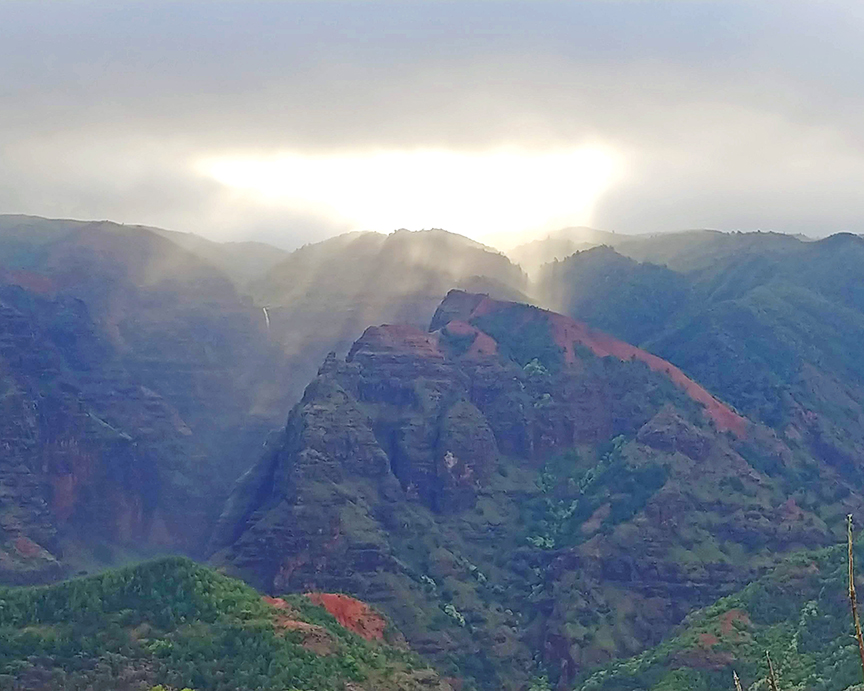By Ruby Pap
![Indicators of climate change in the Pacific Islands region. (Courtesy of Susan Yamamoto, Geovision. Adapted from “Ten Indicators of a Warming World,” in NOAA National Climatic Data Center, State of the Climate 2009 [report].)](https://i0.wp.com/www.forkauaionline.com/wp-content/uploads/2014/11/Ruby-Graphic-Nov-14.jpg?resize=300%2C229)
Indicators of climate change in the Pacific Islands region. (Courtesy of Susan Yamamoto, Geovision. Adapted from “Ten Indicators of a Warming World,” in NOAA National Climatic Data Center, State of the Climate 2009 [report].)
“Maintaining an adequate freshwater supply in the Pacific Island environments is of critical concern as climate change places stresses of uncertain magnitude on already fragile resources,” according to the Pacific Islands Regional Climate Assessment (PIRCA) (2012) http://www.pacificrisa.org/projects/pirca/.
The scientific data behind this statement involves an interesting inquiry into historic trends in air temperature, precipitation, and streamflow, as well as complex modeling of the future based on different climate and emissions scenarios.
Precipitation is the source of all freshwater on the Pacific Islands.
On high islands like Kaua‘i, rainfall is enhanced by the orographic effect. Trade winds carry wet air from the ocean and are driven upward as they encounter the mountains. As the air rises it is cooled and this causes raincloud formation. The trade wind inversion layer (TWI) is a phenomenon that occurs on a point on the highest mountains where the air is warmer than below. This stops the air from rising and clouds from forming.
Greenhouse gas emissions from our global industrialized society are fueling increased air temperatures.
Air temperature has increased significantly globally in Hawai‘i over the last century. Since 1975 increased air temperatures have accelerated, particularly at higher elevations.
With increased warming at higher elevations, rainfall generation is in part being slowed by the TWI. Rainfall has declined over the last century and since 1980 this downward trend has increased.
Additionally, data on historical extreme precipitation events and drought in Hawai‘i show a trend of fewer extremely high rainfall events and longer dry periods.
Accordingly, data show a downward trend in stream baseflow. Baseflow is the groundwater contribution to streamflow measured by stream gauges since 1913.
With global warming, these water trends are expected to continue, although it is more complicated to make future projections. According to the Intergovernmental Panel on Climate Change (IPCC) temperatures are predicted to increase in Hawai‘i under all greenhouse gas emission scenarios.
However, projecting future rainfall in Hawai‘i is more difficult, and the need to ‘downscale’ larger regional models to smaller areas, with fine spatial resolution, is apparent.
One exciting example of such an effort on the island of Maui is underway by the Pacific Regional Integrated Sciences and Assessments (Pacific RISA) program http://www.pacificrisa.org/projects/maui-groundwater-project/. This project will inform sustainability of groundwater resources under different future climate conditions.
Currently, the state government assesses groundwater resources using simplified models that rely heavily on assumptions from the past. To better adapt to changing conditions, a new high resolution hydrologic downscaled global climate model is being used to figure out the impact a changing climate will have on groundwater recharge. It will be interesting to see how this effort plays out on Maui, so that it can be adapted for Kaua‘i and other islands.
As Leonardo Da Vinci so eloquently put, “Water is the driving force of all nature.” Just how this force determines the future of the planet is a moving target, and this is largely due to human interference. However, one comfort I have in the face of these daunting facts is that same human “ingenuity” that fostered the industrial processes and fuels global warming can and is being put towards increased science that will help us to adapt and hopefully give nature a fighting chance.
- Ruby Pap is a Coastal Land Use Extension Agent at University of Hawai‘i Sea Grant College Program. She can be reached at rpap@hawaii.edu.
Discover more from For Kauai Online
Subscribe to get the latest posts to your email.







Leave a Reply